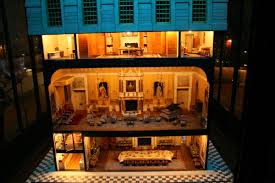Exploring Queen Mary’s Dolls’ House: A Miniature Masterpiece

Introduction
Queen Mary’s Dolls’ House is one of the most remarkable examples of miniature craftsmanship in the world. Located at Windsor Castle, this exquisite dolls’ house was commissioned by Queen Mary, the wife of King George V, in the early 1920s. The intricate details and artistic precision of this structure not only represent a significant aspect of royal history but also highlight the cultural values and craftsmanship of the era.
Historical Significance
Commissioned in 1921 and completed in 1924, Queen Mary’s Dolls’ House was designed by the renowned architect Sir Edwin Lutyens. The house is built to a scale of 1:12, making it a true architectural feat. It features over 50 rooms, each furnished with miniature replicas of period furniture, artwork, and decorative items, many of which were made by skilled artisans of the time. The idea behind the dolls’ house was to represent a microcosm of the royal household, showcasing not only the aesthetic tastes of the time but also the lifestyles of the British aristocracy.
Features of the Dolls’ House
The Dolls’ House includes a variety of rooms such as a library, nursery, and even a wine cellar stocked with miniature wine bottles. Each room is meticulously detailed, with functioning lights, running water in the kitchen, and a garden complete with flowers and pathways. One of the most fascinating aspects is how the dolls’ house is equipped with an extensive collection of handmade items, including tiny silverware by the famous jeweller Garrard, and artworks painted by notable artists of the time. It serves as a testament to the unparalleled craftsmanship and attention to detail of the craftspeople.
Current Events and Public Engagement
Recently, the charm and historical significance of Queen Mary’s Dolls’ House have attracted renewed interest, especially as Royal collections have embraced digital tours and exhibitions. Windsor Castle has allowed virtual access to the dolls’ house, enabling people from across the globe to appreciate this miniature marvel. Furthermore, educational workshops and interactive sessions related to the dolls’ house have been introduced, aimed at engaging younger audiences with history and design.
Conclusion
Queen Mary’s Dolls’ House is more than just a beautifully crafted miniature; it is a vital piece of royal heritage that continues to enchant visitors. Its intricate design and historical significance make it an essential part of British cultural history. With ongoing public interest and the introduction of virtual experiences, the legacy of Queen Mary’s Dolls’ House is likely to inspire generations to come, ensuring its place in the hearts of those who appreciate the artistry and stories of the past.









